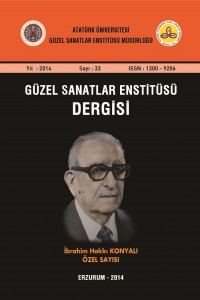Abstract
Anavarza, being accepted as one of the biggest cities of Anatolia, is situated within the border of Dilekkaya Village of Kozan District in Adana. When the city was first established is not known exactly. Strengthening gradually during the Roman period, Anavarza that was annexed by Rome in the 1st century, started to compete with Tarsus, the giant city of the ancient world, in every respect, towards the end of the 2nd century A.D. Since then it became one of the most important metropolises of Anatolia. In the city during the Roman Period; victory arches, column roads, stadium, theater, amphitheater, baths, administrative buildings, temples, aqueducts, etc. so many magnificent structures were built. In this city that continued to enlarge in Byzantine period, churches and chapels were also built besides previous structures. The city, damaged by the frequent earthquakes in the region, was invaded by Arabs in the 8th century and called as Ayn Zarba. Included in Byzantine border by Nicephorus Phocas in 964, Anavarza was captured by Armenians that escaped after Malazgirt victory in the 11th century and Taurus the 1st made Anavarza as capital in 1100. Getting different roles as being capital or border castle, Anavarza was conquered by the Mamluks in 1375 and after that period the completely abandoned city has not seen any large scale settlement. Attracting the attention of various civilizations throughout the ages, Anavarza has also attracted attention of many travelers and researchers since especially the 19th century. The researchers that came to the city are as follows: In 1833, French Charles Texier, in 1840 the British Barker, in 1852, the French Victor Langlois, in 1875, English clergyman Edwin John Davis, in 1882, the British Sir Charles Wilson and Major Bennet, in 1905, the British Gertrude Bell. In this article, 31 photographs taken by Bell who stayed for a while in Anavarza in April, 1905 and did researches are evaluated by comparing it with present day situation
Keywords
Abstract
Anadolu’nun en büyük kentlerinden biri olarak kabul edilen Anavarza; Adana’nın Kozan İlçesi Dilekkaya Köyü sınırları içerisinde yer almaktadır. Kentin ilk olarak ne zaman kurulduğu tam olarak bilinmemektedir. I. yüzyılda Roma topraklarına katılan Anavarza, Roma döneminde giderek güçlenip, M.S. II. yy. sonlarında antik dünyanın dev kenti Tarsus ile her açıdan rekabet eder hale gelmiştir. Bu tarihten itibaren de Anadolu’nun en önemli metropollerinden biri olmuştur. Roma Dönemi’nde kentte; zafer takları, sütunlu yollar, stadyum, tiyatro, amfi tiyatro, hamamlar, idari yapılar, tapınaklar, su kemerleri vb. birbirinden ihtişamlı yapılar inşa edilmiştir. Bizans Dönemi’nde de gelişmeye devam eden kente bu yapıların yanında kiliseler ve şapeller inşa edilmiştir. Bölgede sık meydana gelen depremlerden büyük hasarlar gören kent, VIII. yüzyılda Araplar tarafından zapt edilmiş ve Ayn Zarba olarak anılmıştır. 964 yılında Nicephorus Phocas tarafından tekrar Bizans sınırlarına dâhil edilen Anavarza, XI. yy.’da Malazgirt Zaferi’nden sonra kaçarak Çukurova’ya gelen Ermenilerin eline geçmiş ve I. Toros 1100 yılında Anavarza’yı başkent yapmıştır. Daha sonra başkent veya sınır kalesi olarak değişik roller alan Anavarza, 1375 yılında Memluklular tarafından alınmış ve bu dönemden sonra tamamıyle terk edilen kentte büyük ölçekli bir yerleşim olmamıştır. Çağlar boyu çeşitli uygarlıkların dikkatini çeken Anavarza, özellikle XIX. yüzyıldan başlayarak birçok seyyah ve araştırmacının da dikkatini çekmiştir. Bunlardan; 1833 yılında Fransız Charles Texier, 1840 yılında İngiliz Barker, 1852 yılında Fransız Victor Langlois, 1875 yılında İngiliz rahip Edwin John Davis, 1882’de İngiliz Sir Charles Wilson ve Binbaşı Bennet, 1905 yılında İngiliz Gertrude Bell kente gelen araştırmacıların bazılarıydı. Bu makalede 1905’in Nisan ayında Anavarza’da bir süre kalıp, araştırmalar yapan Bell’in çektiği 31 Anavarza fotoğrafı günümüzdeki durumlarıyla karşılaştırılarak değerlendirilmiştir.
Details
| Primary Language | tr;en |
|---|---|
| Journal Section | Articles |
| Authors | |
| Publication Date | June 9, 2015 |
| Submission Date | June 9, 2015 |
| Published in Issue | Year 2014 Issue: 33 |
Obtaining permissions for studies requiring ethics committee approval regarding the implementation of ethical rules and including information about permission in the article was added to the criteria. In this direction, Ethics Committee Permission is required for articles submitted to our journal and meeting the conditions stated below.
• Any research conducted with qualitative or quantitative approaches that require data collection from participants using questionnaires, interviews, focus group work, observation, experimentation, and interview techniques.
Also;
• Obtaining and indicating permission from the owners for the use of scales, surveys and photographs belonging to others,
• It should be stated that the copyright regulations are complied with for the intellectual and artistic works used.


